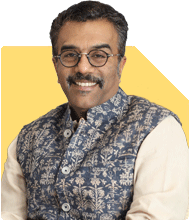Investing Rs. 1000 per month in 5 Mutual Funds - Good for Retirement?
Ramalingam Kalirajan |10902 Answers |Ask -Follow
Mutual Funds, Financial Planning Expert - Answered on Feb 11, 2025
He has an MBA in finance from the University of Madras and is a certified financial planner.
He is the director and chief financial planner at Holistic Investment, a Chennai-based firm that offers financial planning and wealth management advice.... more
Dear Sir, I have started my SIP's of Rs. 1000 each in the following mutual funds from October 2024, 1. Parag Parikh Flexicap Fund Direct Growth. 2. ICICI Prudential Equity and Debt Fund Direct Growth. 3. ICICI Prudential Bluechip Fund Direct Growth. 4. DSP Nifty 50 Equal Weight Index Fund. 5. Quant Small Cap Fund. Since Oct-24 onwards Iam only seeing losses in these funds with negative returns, I know that investments in equity mutual funds give actual returns only after 5 years, but I wanted to ask whether these are good mutual funds for long term growth or whether I should switch to other funds. Iam 43 years of age and I have kept these funds for my retirement, My plan is to increase the SIP every year by 5% and do SWP in them after I retire to get monthly passive income. My second question is how can I generate passive income currently via arbitrage funds, dividend mutual funds are also a good option, but they attract taxation and in my case I fall under the 30% tax slab (under the old regime). Thanks & Regards, Shirin Pathak
Your investment journey is off to a strong start. Equity mutual funds work best over the long term.
It is normal to see losses in the short term. Markets fluctuate, but patience rewards long-term investors.
Your selected funds cover multiple categories, including flexi-cap, blue-chip, small-cap, and hybrid funds.
Actively managed funds provide better growth potential than index funds over long periods.
Direct funds lack professional support. Investing through a Certified Financial Planner (CFP) ensures proper guidance.
Small-cap and flexi-cap funds have high volatility. Stay invested for at least 7-10 years for better returns.
Hybrid funds balance risk and return. They help during market corrections.
Your plan to increase SIPs annually by 5% is excellent. Compounding will help in wealth creation.
Retirement-focused investments should prioritize stability along with growth.
Diversification is good, but too many funds can dilute returns.
Should You Switch Funds?
No need to change funds immediately. Review performance over 3-5 years.
Actively managed large-cap funds can outperform index funds in India’s dynamic market.
Avoid sector funds unless you understand their risks.
Continue investing consistently. Avoid switching based on short-term performance.
Generating Passive Income Through Mutual Funds
Systematic Withdrawal Plans (SWP) after retirement is a smart approach.
Arbitrage funds are low-risk and tax-efficient for short-term income needs.
Dividend mutual funds attract high tax in your 30% bracket. Growth option with SWP is better.
Monthly Income Plans (MIPs) in mutual funds provide stable returns with lower tax impact.
Ultra short-term or liquid funds can also be used for periodic withdrawals.
A mix of equity and debt funds ensures stable income post-retirement.
Tax Considerations for Passive Income
SWP from equity funds is tax-efficient. Long-term capital gains (LTCG) above Rs. 1.25 lakh are taxed at 12.5%.
Debt mutual funds are taxed as per your income tax slab.
Arbitrage funds are classified as equity, making them tax-friendly.
Dividend income is taxed at 30% in your case, making it less attractive.
Finally
Stay patient with your SIPs. Market corrections create buying opportunities.
Review fund performance every year but avoid frequent changes.
Plan passive income carefully to reduce tax burden.
Continue SIPs even after retirement to maintain long-term wealth growth.
A Certified Financial Planner can help optimize your portfolio for retirement and beyond.
Best Regards,
K. Ramalingam, MBA, CFP
Chief Financial Planner
www.holisticinvestment.in
https://www.youtube.com/@HolisticInvestment
You may like to see similar questions and answers below
Sanjeev Govila | Answer |Ask -Follow
Financial Planner - Answered on Feb 06, 2024
Ramalingam Kalirajan |10902 Answers |Ask -Follow
Mutual Funds, Financial Planning Expert - Answered on Apr 04, 2024
Ramalingam Kalirajan |10902 Answers |Ask -Follow
Mutual Funds, Financial Planning Expert - Answered on Aug 13, 2024
Ramalingam Kalirajan |10902 Answers |Ask -Follow
Mutual Funds, Financial Planning Expert - Answered on Jan 09, 2025
Chocko Valliappa |544 Answers |Ask -Follow
Tech Entrepreneur, Educationist - Answered on Dec 18, 2025
Chocko Valliappa |544 Answers |Ask -Follow
Tech Entrepreneur, Educationist - Answered on Dec 18, 2025
Chocko Valliappa |544 Answers |Ask -Follow
Tech Entrepreneur, Educationist - Answered on Dec 18, 2025
Anu Krishna |1751 Answers |Ask -Follow
Relationships Expert, Mind Coach - Answered on Dec 18, 2025
Chocko Valliappa |544 Answers |Ask -Follow
Tech Entrepreneur, Educationist - Answered on Dec 18, 2025
Chocko Valliappa |544 Answers |Ask -Follow
Tech Entrepreneur, Educationist - Answered on Dec 18, 2025
Naveenn Kummar |236 Answers |Ask -Follow
Financial Planner, MF, Insurance Expert - Answered on Dec 18, 2025
Anu Krishna |1751 Answers |Ask -Follow
Relationships Expert, Mind Coach - Answered on Dec 17, 2025
Anu Krishna |1751 Answers |Ask -Follow
Relationships Expert, Mind Coach - Answered on Dec 17, 2025
Radheshyam Zanwar |6748 Answers |Ask -Follow
MHT-CET, IIT-JEE, NEET-UG Expert - Answered on Dec 17, 2025


























